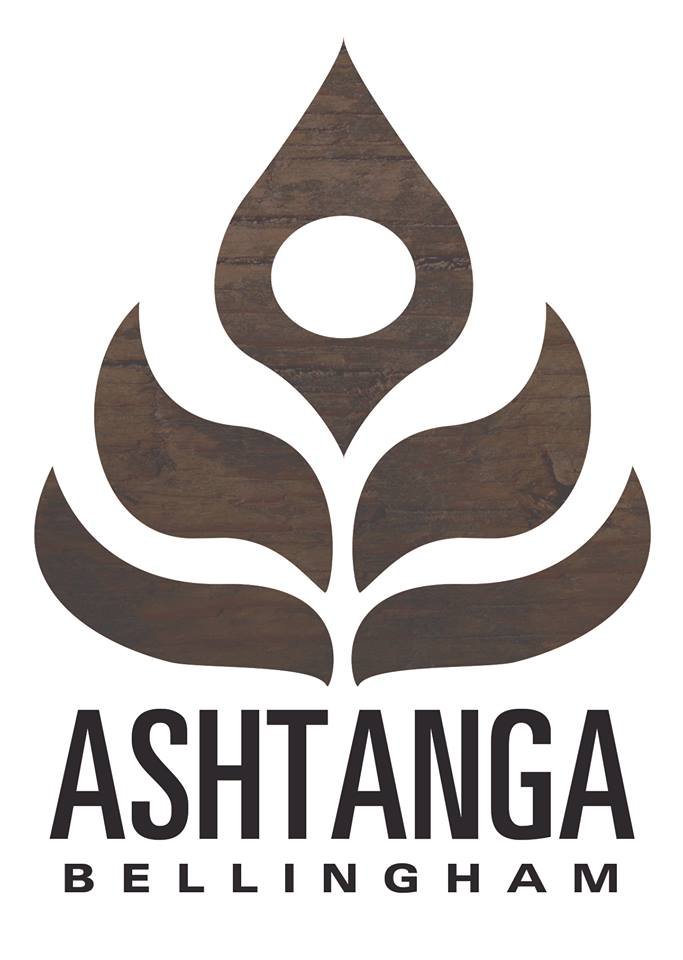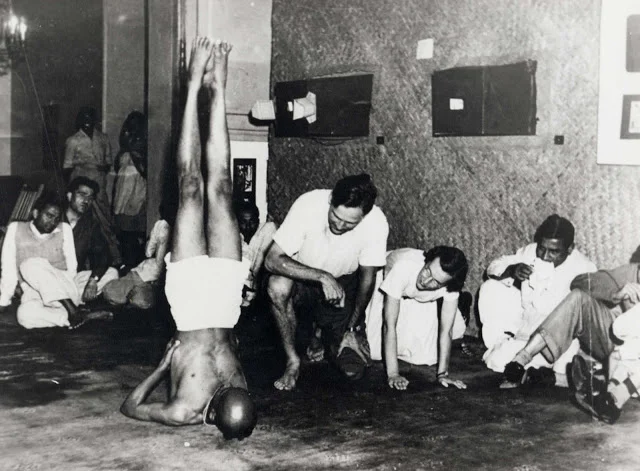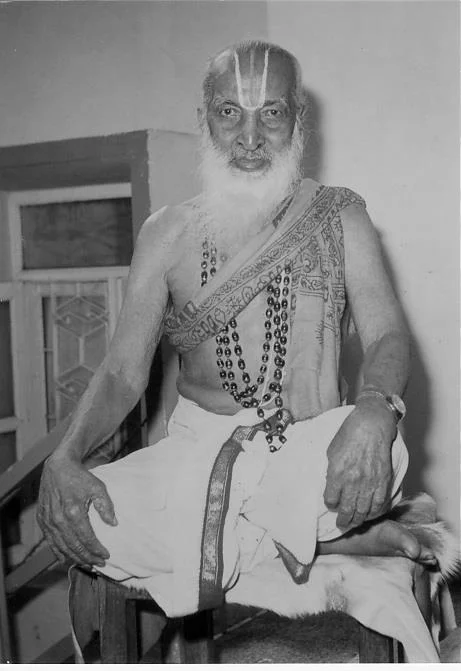The Story of how Ashtanga Yoga came to Washington State
T. Krishnamacharya teaching the yoga posture Janu Sirsasana
Ashtanga Yoga is the format of yoga that has come to us through a lineage existent in ancient times through the Yoga Sutras of Patanjali, and through other yoga shastras. Ashtanga Yoga, as outlined in the yoga sutras (sutras 2:23-29), is a means of removing avidya (ignorance of the nature of dualistic reality), through an eight limbed method of practice in life. Ashtanga Yoga is a humanistic creation, spawning from the oldest philosophical system known to humanity, called Samkhya.
Because Ashtanga Yoga prizes the individual search for the self through samadhi (union or absorption with an object), the system was not a prominent part of society. In fact, most yogis through time lived a life of asceticism, renouncing most worldly and material concerns. Therefore, the Ashtanga Yoga system existed in relative obscurity until the early 20th century when the last remaining master of yoga, Sri Ramamohana Brahmachari took pity on a young Brahmin named Tirumalai Krishnamacharya, and over the course of 7 years, taught him the secrets of yoga at the base of the Himalayas. This great teacher instructed his student to give yoga to the world, as it was sick and needed healing. If it were not for this one order given and honored by a yoga teacher and a yoga student, none of us would have yoga in our lives as we know it today. The method was Ashtanga Yoga, and a legendary document called the Yoga Korunta, that outlined sequences and forms of hatha yoga, which through the research efforts, and translation of the great yogi T. Krishnamacharya, brought yoga back to the world after a long period of slumber, and given to all people. It was from this one man that yoga was reborn.
Sri K Pattabhi Jois demonstrating salamba sarvangasana (shoulderstand)
Krishnamacharya acted out of the norm for his brahmin caste and married a woman whom he loved, but was not arranged to be married. He traveled India, and honored the commission of his teacher, to give yoga to all people. It was during these travels that he happened to be called upon by the King of Mysore to teach him yoga, as he was very sick (Mysore is a large city in Southern India very famous for its role in yogas history). Eventually, this king would come to find great value in yoga, and constructed a yoga school in Mysore on the palace grounds. This legendary school still exists today as a landmark for modern day yoga. It is the legacy of this city, and the generosity of this king, which gave Ashtanga Yoga a solid footing by which it could be researched and refined over many decades.
It was one of Krishnamacharya’s early students, and a Sanskrit professor, Sri K Pattabhi Jois, who would eventually take over as leader of the type of yoga taught at the Royal Palace grounds in Mysore, India. In the 1950s, another of Krishnamacharya’s first students, Indra Devi, came to America and opened the first hatha yoga school in the US, in Los Angeles, where she taught celebrities and thus yoga gained in popularity. Also in the 1950s the first descriptive book on hatha yoga was published, called “Light on Yoga”, by BKS Iyengar, another of Krishnamacharya’s students. By the late 1960s and early 1970s, Americans and Europeans began seeking Jois out to learn the ancient form of Vinyasa Yoga, as it was originally taught in Mysore. From there comes the term “Mysore Style” or “Mysore Class”, as it is done in the style that was taught at the famous yoga shala of Sri K Pattabhi Jois.
BKS Iyengar (left) and Sri K Pattabhi Jois (right). Two of the most influential yoga students of T. Krishnamacharya.
By the 1990s the original Ashtanga Yoga system taught by Krishnamacharya in Mysore, and the meticulously adapted form of Ashtanga taught by BKS Iyengar, had influenced the United States greatly. The awkwardly pronounced sanskrit word “Ashtanga” (meaning “8 limbs”) was then called “power yoga” originally by people in Southern California, who began opening large yoga studios in the model of the fitness industry. Over time, in the US, yoga lost its method of transmission from one teacher to one student, and took the format of the more profitable fitness industry. Jois, the contemporary master of Ashtanga Yoga (also known as “Ashtanga vinyasa” yoga) voiced displeasure with the way that American consumerism had turned the practice of yoga into a “circus”.
As traditional Ashtanga Yoga, with its devotional practices, intense discipline, culturally distant (to Westerners) Sanskrit counting system and challenging postures, became more obscure, more and more trendy styles of yoga invented by Americans took pieces from it, profiting from its vital energy giving systems. While these styles of yoga were giving great health benefits through the intrinsic power of hatha yoga practices, they certainly were not teaching yoga in the manner that it was designed. Certain traditions exist within the structure of Ashtanga, and the system, being holistic, gives the highest benefits from those who pursue it in the manner in which our ancestors took great care in constructing. Sri K Pattabhi Jois remained steadfast in teaching Ashtanga Yoga in its original format, up until his death in 2009. At that time, roughly 30 people around the world were certified from Jois to teach Ashtanga Yoga. Ashtanga Yoga School of Bellingham’s founder has practiced under 5 of these 30 original certified teachers of Pattabhi Jois (although never directly under him).
David and Luke in 2009
The people of the Pacific Northwest would be uniquely blessed with two certified Ashtanga Yoga teachers. One a local from Seattle, and another a woman from France. Both were dedicated students of Pattabhi Jois, and they started the Ashtanga Yoga School of Seattle. Shortly after its invention, Sri K Pattabhi Jois took a trip to Seattle to bless the efforts of two of his most devoted students, David Garrigues and Catherine Tisseront. This visit would ignite the fire of Ashtanga in the Pacific Northwest. For many years, Seattle was a gathering place for dedicated Ashtanga practitioners. The director of Ashtanga Yoga School of Bellingham, Luke Baugh, was a student of the Ashtanga Yoga School of Seattle, under these two teachers, starting in 2005.
Within recent years, our northwest Ashtanga Yoga community has went through many changes. The Ashtanga Yoga School of Seattle disbanded as Catherine Tisseront passed away, shortly after Luke started his own school. Sri K Pattabhi Jois and BKS Iyengar, also passed away within a few years. The lack of leadership from these pillars of the Ashtanga Yoga lineage left the ancient teachings of Ashtanga Yoga even more vulnerable to the economic and commercially driven profiteers of the West. While yogic masters are now available at the touch of a button through the surge of internet based yoga instruction, and more and more new yoga teachers are coming into the fold having little to no connection to the original lineage that spawned this great and now global movement; something is missing. The local yoga school, where teachers and students gather to learn from each other, is perhaps more important now than ever to provide instruction and guidance for students who are overburdened with information and a lack of connection to the meaning of the practice. Ashtanga Yoga School of Bellingham remains connected to the ancestry and traditions of Ashtanga Yoga through continual practice in our lineage, and support of the Ashtanga community in our region and globally.
Luke Baugh in eka pada sirsasana, at his yoga school circa 2008
Today, over 90,000 registered yoga teachers exist in the USA, and nearly 700 registered yoga teachers are within 50 miles of Bellingham alone. Many yoga teachers call their practice “hatha”, “vinyasa”, “flow”, or “alignment” yoga; most all of these types of yoga are explorations into aspects of the systems of Ashtanga Yoga taught by Krishnamacharya, and a few others. When we go to a yoga class, meet a yoga teacher, or take an online course, perhaps we should ask them; “who is your teacher, and where did this style of yoga come from?”, and keep in mind that it is the tradition of yoga itself, a gift from the ancestral people of India, who instruct us to continue learning in an unbroken lineage, in the spirit of devotion to the practice, so that those to come after us may also benefit. Ask yourself if you believe it to be appropriate to change thousands of years of dedication, from people who served the lineage of yoga, giving their lives to the science so that we may benefit from it. Would it not be appropriate to honor them by learning their methods, learn from their experiences, their texts, and the practices they taught, which are still alive through the lineage today?
David and Luke (with Andrew) in 2022. Practicing together for nearly 20 years at time of this picture.
While there are certainly advantages to having greater access to yoga through internet and an increased number of teachers, there are some things that have been lost to our detriment, and one of them is the vital sanctity of a local yoga shala (school), which honors the traditions and formats of the system of yoga that has been given to the world after thousands of years of dedication and research from honorable ancestors of humanity. In todays yoga “industry”, it almost seems that the deep spiritual practice of yoga has been rebranded as an exotic form of exercise, or performance art. Those who seek to find the nectar within the scriptures and practice of yoga know that we must learn under the guidance of those that studied before us. Those who seek practice under the teachings of yoga will undoubtedly find the sweetness of yoga. Ashtanga Yoga School of Bellingham seeks to be a space for our community members who wish to undertake the practice of yoga in this light.
Notably, while we are a traditional yoga school by comparison to others, and our asana sequences are based on the vinyasa sequences of Sri K Pattabhi Jois, and the great T. Krishnamacharya, we hold a non-dogmatic view towards the progression of asana, and seek to advance our knowledge of it through playful and devoted experiential research. Ashtanga Yoga, which is the method of yoga practice outlined in the Yoga Sutras of Patanjali, and from which has come nearly all yoga practiced today, is accessible to all people.
Ashtanga Yoga School of Bellingham is here to provide a space for students and teachers of yoga to continually refine our understanding of asana, while we live in harmony with the principles of our practice, the teachings of our teachers, the traditions of lineage, and seek to honor those wise yogis that came before us, in India, to give us this practice. We seek to gain real knowledge (yoga sutra 1.7) through continual practice of the sequences and forms given to us by our lineage, and by relying on the wisdom of the ancient masters who wrote yoga shastras such as the Siva Samhita, Hatha Yoga Pradipika, Yoga Sutras, Samkhya Yoga Karika, and more. We realize that to seek understanding of yoga without guidance is vanity; thus, we humbly take practice daily in the spirit of devotion towards truth, with the bright light of tapas burning inside.
The great yogi T. Krishnamacharya
We are here to share our practice and understanding of the 8 limbs of yoga, and find platforms of understanding and community, where this understanding can take root, and develop within the hearts of practitioners who seek to gain the knowledge from continual, devoted practice (Yoga Sutra 1:14). The practice of Ashtanga Yoga has been often misunderstood, and practiced incorrectly by many people. We cannot do anything to remedy those misunderstandings, but for those that seek out the nectar of Ashtanga, we can provide a place of practice for you. Yoga of this method all came from one place, and for several generations, and has been passed from teacher to student, in an unbroken lineage called parampara. Please join us in participating in our devotional practice of Ashtanga Yoga, the practice of the 8 limbs, as outlined by the great sage Patanjali. You too can take practice!
Om.







